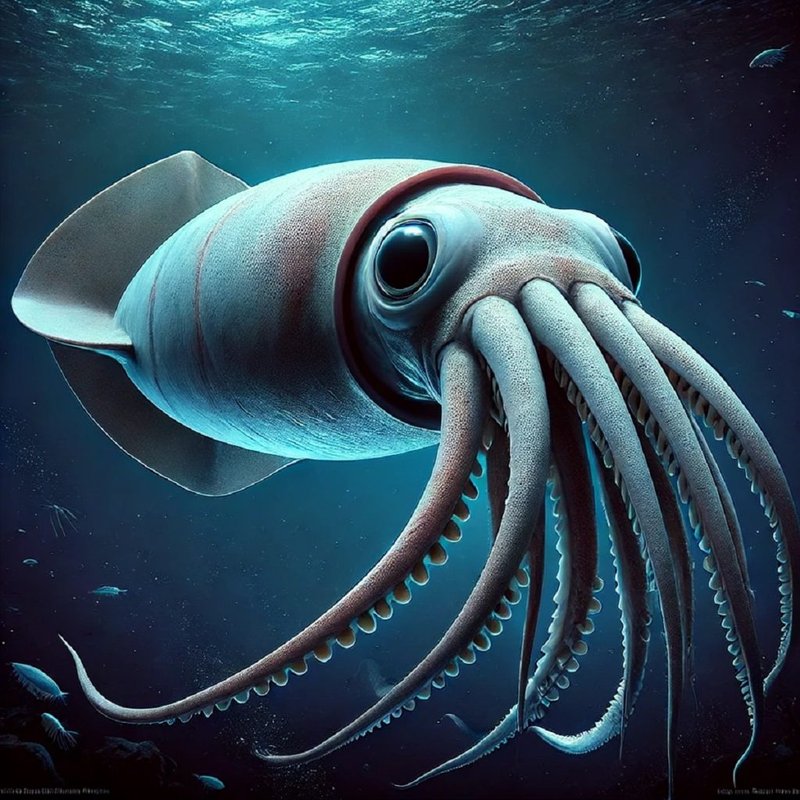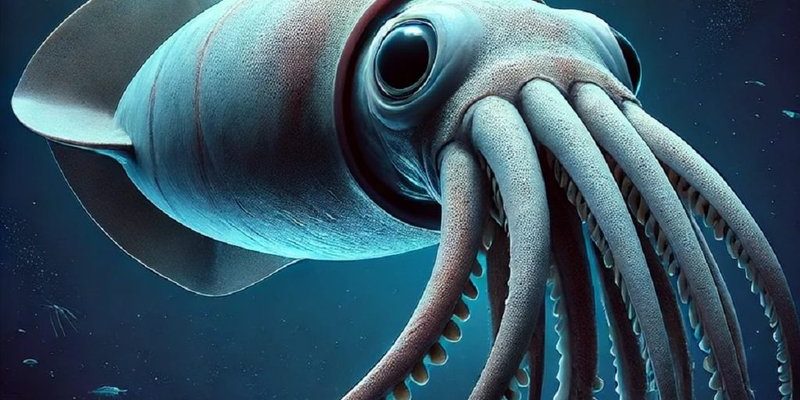
Think of the ocean as a vast, underwater wilderness filled with challenges. From crushing pressures to near-total darkness, the giant squid has transformed itself into a master of this environment. Let me explain how these adaptations make it not just a survivor, but a successful predator in its deep-sea domain.
1. The Body Structure of the Giant Squid
When you look at a giant squid, its unique shape stands out immediately. Their bodies are streamlined, almost like torpedoes, which helps them move swiftly through the water. With a head that resembles a large bulb and long, muscular arms, they can zoom ahead to catch prey or escape predators.
These squids possess a soft, gelatinous body, which reduces their weight, allowing them to float at different depths with minimal effort. This buoyancy is crucial when navigating the ocean’s varied layers. Additionally, their ability to contract and expand helps them adjust to the water pressure as they move deeper.
Interestingly, giant squids have a unique internal structure called the cuttlefish bone. This structure adds support without weighing them down too much. It’s like having a sturdy, lightweight backbone that helps maintain their shape while giving them the flexibility to dart around.
2. Camouflage and Color Change
You might be surprised to learn that giant squids are masters of disguise! They can change their color and texture in the blink of an eye. This is thanks to special cells in their skin called chromatophores, which are filled with pigments.
When a giant squid feels threatened or wants to blend into its surroundings, it can expand or contract these cells. Imagine a chameleon; it can go from bright reds and yellows to deep blues and grays, matching the ocean floor or even the murky water around them. This skill is not just for hiding; it also plays a role in communication with other squids.
The ability to camouflage is crucial for a predator like the giant squid. It allows them to ambush prey—think of a surprise attack in a game of hide and seek. It’s a strategy that ensures they can keep feeding, even in a world where many animals are always on the lookout for a meal.
3. Exceptional Eyesight
In the dark, underwater world where sunlight barely penetrates, having good eyesight is essential. The giant squid boasts some of the largest eyes in the animal kingdom, reaching about the size of a basketball! This may sound dramatic, but it’s all about survival.
These massive eyes are specifically adapted to detect light in the murky depths. Their large surface area captures more light, giving them an advantage when spotting both prey and predators. So, if you’re swimming alongside a giant squid, be assured, they definitely can see you!
Moreover, their eyes are designed to focus on both near and distant objects. This skill helps them navigate the vast ocean efficiently and increases their hunting success rates. It’s like having a perfect pair of binoculars right on their face!
4. Speed and Agility
Speed is a key factor when it comes to survival underwater, and giant squids are no slouches. They can propel themselves through the water using a unique method known as jet propulsion. Here’s how it works: they suck water into their bodies and then expel it forcefully, allowing them to shoot forward in a burst of speed.
This method not only helps them escape from larger predators, like sperm whales, but also enables them to chase down faster prey. When you think about it, it’s like a car turbo charging to overtake another vehicle in a race.
In addition to their jet propulsion system, giant squids have muscular arms equipped with suckers. These suckers are not just for grabbing onto things; they also help in stabilizing movement while swimming. So, as they dart through the ocean, they can make sharp turns or sudden changes in direction, enhancing their agility.
5. Advanced Hunting Skills
Being a predator in the deep sea isn’t just about strength; it’s also about strategy. Giant squids have developed some impressive hunting skills. With their long arms, they can reach out and grab prey quickly. But here’s the kicker—they often hunt in darkness, which means they rely heavily on their senses.
Giant squids can detect vibrations in the water, helping them locate moving prey like fish or smaller squid. This ability is somewhat similar to how a blind person might use their hearing to navigate a noisy room. They might not see their dinner, but they sure know when it’s close by!
Once they have their target in sight, they use their speed and agility to launch an attack. They can swiftly ensnare prey in their arms and use their sharp beaks to take a bite out of their next meal. It’s a thrilling moment, showcasing the squids’ keen instincts and predatory skills.
6. Unique Defense Mechanisms
Every creature needs a way to defend itself, especially in a world filled with dangers. Giant squids have developed several clever strategies to avoid becoming someone else’s dinner. One of their primary defense mechanisms is ink expulsion. When threatened, they can release a cloud of ink, creating a smoky curtain in the water.
This ink not only confuses potential attackers but also allows the squid to make a quick escape. It’s like if someone threw a smoke bomb during a game of tag—perfect for slipping away! In the chaos, they can swim to safety while the predator is distracted.
Additionally, giant squids possess a muscular body that allows them to evade capture by changing directions rapidly. Combining their ink defense with their ability to disappear into the darkness makes them formidable opponents in the deep sea.
7. Reproductive Strategies
Reproduction is another crucial aspect of the giant squid’s survival. These creatures have unique reproductive strategies to ensure the continuation of their species. During mating, males engage in an intricate dance to attract females. Once a male wins a female’s attention, he transfers spermatophores—packages of sperm—to her using specialized arms.
After mating, females lay thousands of eggs in the deep ocean. They often provide no care for the eggs after laying them, which may seem risky. However, the sheer number of eggs increases the chances that some will survive to adulthood.
This reproductive strategy is a numbers game, designed to counteract the high mortality rate of squids. By producing many offspring at once, they ensure that at least a few will grow up, thrive, and become the next generation of giant squids.
In essence, these adaptations reveal just how incredible and resilient the giant squid really is. Their ability to thrive underwater, despite numerous challenges, is a testament to nature’s ingenuity.
As we continue to explore the ocean, who knows what other amazing adaptations we might discover in the creatures that call it home? The giant squid serves as a reminder of the wonders of evolution and the mysteries of the deep sea.

